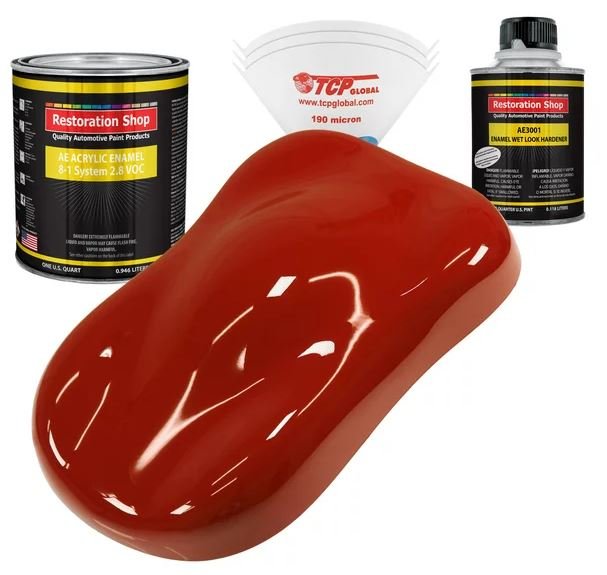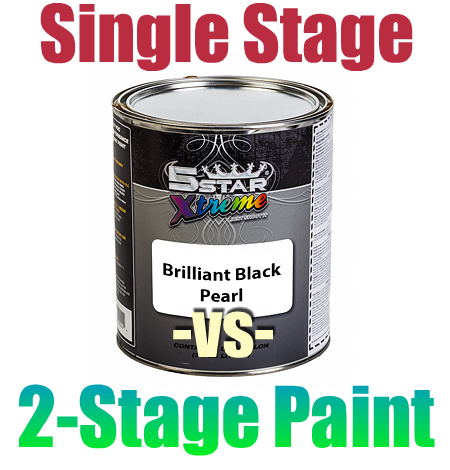I get a significant number of do-it-yourself people asking me, “what is single stage paint, and should I use this for my car to save money painting it myself?” That’s a loaded question that will take a lot of discussion to answer.
We’ll start with the basics of exactly what IS single stage automotive paint, and then we’ll get into the ramifications of a single stage paint DIY project. Let’s dig in!
First off, single stage automotive paint is a type of paint coating that is exactly as it sounds… it’s a 1-step shiny paint that you can put on your car project. You can shoot the paint on in a single stage, as opposed to 2-stage paint, which requires you spraying a layer of base coat, and then a layer of clear coat.
When you spray on 2-stage base coat paint, it’s dull. It has a matte finish effect, because you’ve got to spray on the clear coat to bring out the shine and show off the pearls. Single stage paint is shiny right out of the gun. How do they do this? Easy. They mix in the clear coat right with the base color ingredients.
There are advantages and disadvantages to using single stage paint, and I know this from experience as a “DIY-painter-turned-into-body-shop-owner” professional. I won’t get all overly fancy on you like the other body shop professionals, because I can relate as an original DIY’er myself, and I can explain it in plain English terms.
Without making this post longer than it has to be, we are assuming that the vehicle is properly prepped and/or shot with primer before the single stage paint is applied. All of this information will be valid for the DIY’er, but also valuable for those who opt for having a body shop apply the paint.
Let’s cover all good & bad, and get you up to speed!
Advantages of Single Stage Paint
1) Cost - the biggest reason people consider using single stage paint. When you’re cutting out half of the necessary paint to finish the job, half the cost stays in your pocket.
Base coats and clear coats can get super expensive, ranging anywhere from a few hundred bucks to $1,000 for all of the components. However, most single stage paints can be purchased between $75 and $200 per gallon. 1 to 2 gallons is usually what is needed for a medium-sized vehicle.
2) Time of Application - it takes less than half the time to shoot single stage paint. Once you’ve got a car masked off and ready to shoot, you’ll only need to apply a couple of layers and you’re done.
2-stage paint requires laying down a couple of base coats allowing roughly 15 minutes to “flash” (that’s where the thinner, or “reducer” evaporates from the paint) in between coats, and then 2 to 3 layers of clear coat with an equal flash time in between. That’s more than double the time required for putting down a single stage paint job, thanks to the wait time for allowing each layer to “flash”.
3) Great for Small Projects - it’s the clear choice when you don’t want to “overdo” a project.
If you’re trying to paint one small panel on your beater car to make it look a little better and prevent it from rusting, single stage paint is a great choice. It’s also the better choice for painting panel covers on riding lawn mowers & other miscellaneous metal parts that you just don’t want to go overboard on.
It makes sense to consider the end-use of a project, and its overall value before investing money into the paint job. If your 1995 Ford Taurus that has one foot already in the graveyard needs a panel painted, you can have your local auto parts store mix a quart of single stage paint made to match the color of the car fairly accurately, and at a low price.
Disadvantages of Single State Paint
This is where it gets a little ugly. The reasons for not using single stage paint are more than likely going to steal the show for you. This will be eye-opening for you if you’re learning about this for the first time. Let’s get into the details!
1) The Durability Sucks - single stage paint does not have a good life span compared to 2-stage paint.
I don’t ever consider single stage paint as an option for a “nice” vehicle at my body shop. Durability is the #1 reason. You’re just not going to get the protection from the elements with single stage paint like you would with a 2-stage base coat/clear coat system.
Once you start to develop cracks, fissures, and oxidation in the paint, it’s a done deal. You have one layer to protect your car from what is underneath. Sure, you’ve probably got a layer of primer under the new paint, but once your paint layers fail, the primer won’t be enough to protect it from the damage it will get from the rain, sun, sleet, snow, and road salt.
The primary purpose of painting a car is to protect it from said damage due to the elements. Therefore, “more” is better. Sorry single stage, you lose big time on this point.
2) It Doesn’t Look Good - single stage paint cannot compete with 2-stage paint when it comes to creating that showroom shine.
As I mentioned before, the way they get single stage paint to lay down with a shiny gloss is by mixing in the clear coat into the base color components. What you’re getting is a “stained glass window” type of effect. Yes, the paint will be shiny… but you will have a noticeably duller finish than what you’d get with 2-stage paint.
Think of 2-stage paint like a big sheet of glass on a fine hardwood table that has been finish sanded and stained, compared to a hardwood table that doesn’t have a glass top, but has been shined and buffed with furniture polish. There’s just no comparison.
It is possible to wet sand, buff, and polish single stage paint to make it shine better. Some people get fantastic results. But sanding and polishing single stage paint reduces the thickness of the material’s coating on the vehicle. The thinner the coating, the less protection you have. Plus, it just would not make sense to spend the time and money doing finish work on cheap paint.
3) Exact Color Match is Difficult - you might not be able to match the exact hue on a newer vehicle.
If you’re a picky person and you’ve got a newer car that needs a panel repainted, you can forget single stage paint. Doing this yourself is not to be advised. It’s hard enough to match 2-stage paint to perfectly match existing paint on a car. It’s much worse with single stage.
The single stage paint will have less of the color pigments of its 2-stage counterpart. Plus, single state paint will not reflect the light in the same way, due to the clear coat being distributed throughout. That might not sound significant, but it will make a repaired panel stick out like a sore thumb.
Single stage paint is really only an option for a complete paint job if you don’t want to notice any glaring differences. But I would not advise doing a complete paint job in single stage paint for any of my customers. In fact, I wouldn’t even do it if someone requested it. They’d have to go down the road to Uncle Jed’s Paint Shed before I risked my reputation on such a project.
4) It’s VERY Difficult to Shoot - DIY people, pay close attention to this point!
Single stage paint is definitely NOT for the beginner. In fact, it’s hard for seasoned paint & body techs to shoot single stage paint without having problems. That’s why I highly recommend against its use for the do-it-yourself crowd.
When shooting 2-stage paint, putting on the base coat is the easiest paint you’ll ever spray. It’s as close to “fool-proof” as it can be. If you don’t lay it on too heavy, you’re not likely to get any runs or sags. All you have to do is shoot it per the manufacturer’s specifications and you won’t have any problems… most of the time.
Clear coat is a horse of a different color. It’s the hardest of paints to shoot. You can spray it on “dry”, which leaves a dull, grainy finish that doesn’t shine. You can lay it on too thick in spots, and get runs. And you can also put on too much overall, and get sags.
There are SO many minute details that have to be considered to get clear coat to lay on right. You’ve got to have the right temperature, moisture control, a good atomization out of the gun, proper pressure at the gun tip, the right distance from the surface, laying it on at the right speed, proper overlap, and more. Clear coat is very persnickety.
You might wonder why I bring this up as a point against single stage paint, because it sure sounds like a reason to use it. But do you remember what single stage paint is comprised of? Yes, base color with the clear coat mixed right in.
That means that each and every problem I just described regarding clear coat will be a problem you’ll have using single stage paint. It’s NOT beginner-friendly, and you can end up creating a real mess if your shoot goes wrong.
Conclusion
By now you can probably guess that I don’t recommend using single stage paint for the majority of applications. But if you’re really into painting, and have the patience to learn how to perfect the process, single stage paint can be your friend.
As I mentioned before, there are those who can apply single stage paint and achieve spectacular results when doing all of the required finish work. If you’re wanting to do a repair on a newer vehicle that you might resell in the future, get a professional body shop to apply a 2-stage paint job. But if you’re feeling froggy and want a challenge, single stage paint can work if you pay close attention to detail and apply it properly.
I highly recommend using a quality single stage paint from a trusted manufacturer. Hit the links below to view and purchase paints from the manufacturers that I have used in the past via Amazon, and in doing so, you’ll help to support the Carltonzone “Body Shop Tips” mini blog where you’ll be able to ask questions and get advice from the pros!
Carlton Flowers
Color Boss Custom Auto Body Shop




